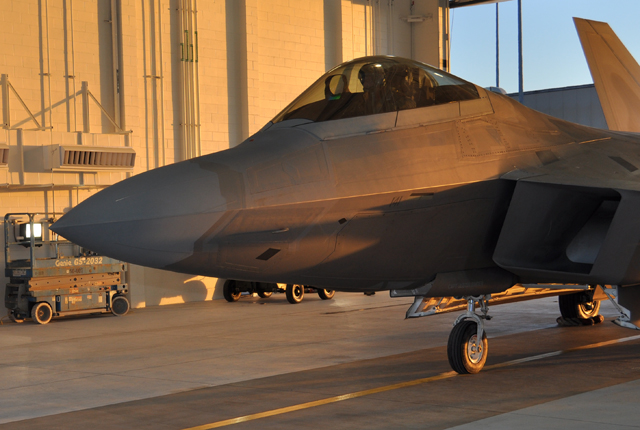The US Air Force expects to start fielding life support systems modifications for its fleet of Lockheed Martin F-22 Raptor air superiority fighters this January.
"UPG [upper pressure garment] valves are being shipped now, and the vests will be modified locally," says the USAF's Air Combat Command (ACC). "We expect units will start flying with the modified vests later this month, which alleviates the current restriction that has them flying without the vests at altitudes below 44,000 feet unless otherwise directed."
The Raptor, which is regarded as the USAF's premier air-to-air fighter, had been operating under a number of operational limitations because of a suspected problem with the aircraft's onboard oxygen generation system (OBOGS). The problem was severe enough that the USAF was forced to ground the Raptor for four months in 2011 after more than a dozen "physiological incidents" with symptoms resembling hypoxia. After the USAF concluded that the pilot's Combat Edge upper pressure garment was the source of the problem, the service has slowly been lifting restrictions on the Raptor's operations. Other than the altitude limitation, the only other remaining restriction on F-22 is that the aircraft is currently precluded from executing the Alaska air sovereignty mission.
 |
|---|
USAF |
Once an automatic back-up oxygen system (A-BOS) is fielded, F-22s based at Joint Base Elmendorf-Richardson will be cleared to perform the air sovereignty mission over Alaska. "This meets the condition for approving F-22s to resume the air sovereignty mission in Alaska," ACC says. "A-BOS units are now installed on aircraft for evaluation purposes, and we remain on track to begin modifications to other aircraft--starting with Elmendorf--within the next couple months."
Currently, other aircraft, mostly Boeing F-15C Eagles, have been covering for the Raptors.
The USAF is also investigating the Raptor's OBOGS oxygen schedule, which might be providing too high an oxygen concentration, leading to a condition called acceleration atelectasis. "We're analyzing the O2 scheduling issue, but there's no firm timeline associated with testing or potential modifications so I can't characterize how far along that is other than to say it's ongoing," ACC says. "The major step taken by the task force with respect to O2 concentration last spring was to reduce pilots' susceptibility to atelectasis by discontinuing the requirement to fly at a "max" OBOGS setting."
Kevin Divers, a former USAF F-22 flight test engineer and aerospace physiologist, says, "Atelectasis was a problem before the "max" setting requirement, so norm doesn't reduce it from where it was when the issues started happening."
Further, Divers says, the USAF has already studied a modified Raptor's oxygen concentration schedule in detail. "It was all set to go, just not funded," he says. But ACC counters, "Further adjustments to O2 scheduling require more study, since the benefits or unintended consequences of revising the schedule are not as clear-cut as some sources might suggest."
But Divers goes further, he says that the USAF has missed the true root cause of the Raptor's oxygen woes. "They still are missing it and there will be issues that creep up," he predicts. "The vest fix will make them more comfortable, but won't solve the root cause."
Source: Flight International
















